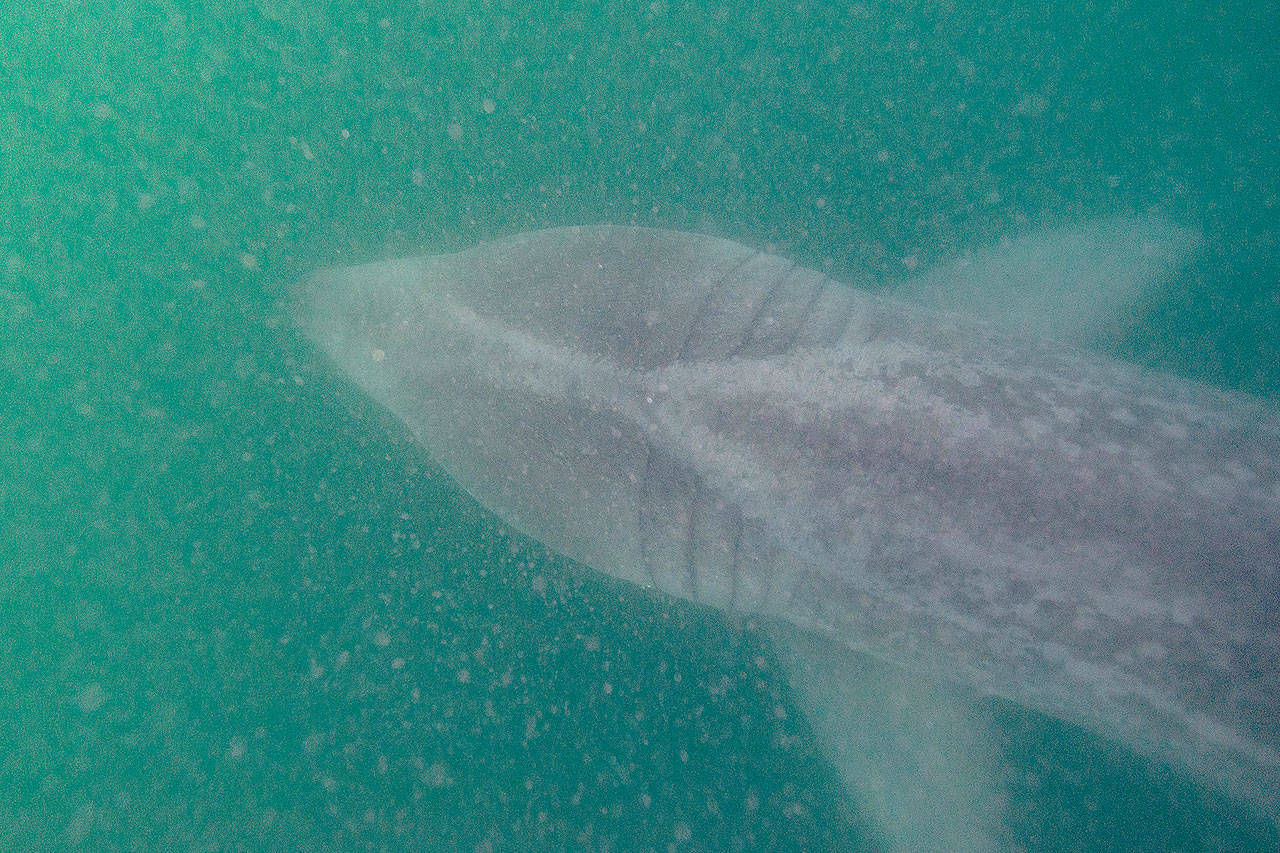LOS ANGELES — Ryan Lawler saw the dorsal fin in the distance, swaying slowly side to side, and assumed it was a great white shark. As his boat got closer, he saw the massive fish’s snout sticking out of the water, its mouth wide open.
Without fear, Lawler jumped in — to swim with the elusive basking shark.
“It was something we’d been dreaming about,” Lawler said. The owner of Pacific Offshore Expeditions had heard of basking sharks showing up recently along the Channel Islands and gone in search of one, as a kind of marine life bucket list item.
With some measuring more than 30 feet long, basking sharks are second in size only to whale sharks and are completely harmless. They have tiny teeth, and feed on copepods such as krill and plankton.
In the early to mid-1900s, the huge fish were abundant along the West Coast, numbering in the hundreds and possibly thousands, said Heidi Dewar, a research biologist with the National Oceanic and Atmospheric Administration.
Around the 1960s, the fish all but disappeared, possibly because they were harvested for their valuable fins and livers, or eliminated after interfering with salmon fishing in Canada, Dewar said.
Starting in 2009, NOAA included basking sharks in its “species of concern” program and started asking for the public’s help in spotting them. In the last few years, there have been only occasional sightings.
Now, the animal appears to be making a comeback.
Recent reports indicate that groups of 10 to 20 sharks have been swimming in the Santa Barbara Channel, and individual sightings appear to have increased as well. Scientists know so little about the sharks that they find it difficult to explain why they apparently have returned —and whether they might stick around.
The excitement began in mid-April, when an Island Packers Cruises boat arrived at Santa Cruz Island. Disembarking passengers chattered excitedly about a group of about 15 giant sharks, which had been swimming lazily around their boat. NOAA was immediately notified.
“They came in raving about it,” said Cherryl Connally, co-owner of Island Packers Cruises. “The crowd of people was ‘oohing’ and ‘aahing.’ There were so many of them.”
Recently, people have spotted the sharks off Santa Cruz Island every other day, Connally said. Though most sightings have been in the Santa Barbara Channel, there also have been reports of basking sharks in Ventura, Santa Monica and Long Beach waters.
Dan Salas, chief executive and founder of Harbor Breeze Cruises in Long Beach, said passengers have seen seven or eight basking sharks on their excursions since the beginning of the year. Salas said he has seen five in his lifetime —and three of those were this year.
“They’re like the Loch Ness Monster,” he said. “You hear these stories of them, but it’s really hard to get a picture.”
For him, the reason for the animals’ return is clear.
“The conditions are just perfect for marine life right now,” he said. Temperatures are warming. And it’s possible that freshwater runoff from recent rains has drained nutrients into the ocean, making plankton grow, he said.
Recent changes in climate patterns and ocean temperatures have resulted in all sorts of strange things happening in the waters off the West Coast. In February, for example, University of California, Santa Barbara staff members found a rare hoodwinker sunfish, or Mola tecta, the first one recorded in the Northern Hemisphere.
In that case, NOAA ecologist Elliott Hazen said, ocean warming could be the reason the species moved north, as have many other sea creatures. The same is true for the food that the basking sharks are following, he said.
The copepods also could be benefiting from the freshwater runoff, although it sometimes can be harmful because it helps poisonous algae grow, which if ingested can sicken or kill some marine mammals. Experts think that was the case in March, when dolphins were becoming stranded and dying in excessive numbers on Orange County beaches.
Though scientists agree that the return of the basking shark may have something to do with environmental factors, they hesitate to draw conclusions because there is so little baseline information about the species.
“I wish I had a good answer,” Dewar said. “We definitely know the ocean is changing.”
The problem, Dewar said, is that scientists don’t know how the animals behave even in normal conditions. And recent changes in the climate have only complicated matters.
Sharks in general take longer than other marine animals to mature to reproductive age and have small numbers of offspring, said Ryan Freedman, a researcher who works with NOAA to track the basking sharks. That could explain why the animals seemed to be gone from Southern California waters for so long.
It’s likely that the increase in sightings means the population is finally recovering after years of being decimated, Freedman said.
And that presents elated scientists with the opportunity to properly track and research the basking sharks.
Freedman tagged two more in April, and he’s ready with four additional tags should he encounter more of the gentle giants. The tags are equipped with satellite technology and attached next to a shark’s dorsal fin. They gather information about depth, light and temperature to make estimates about where the shark ventures.
After a few months, the tags fall off and rise to the surface of the ocean. Then, more satellite data are transmitted to scientists.


